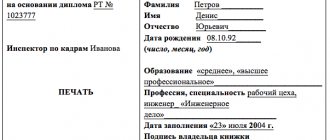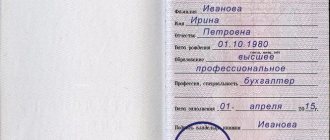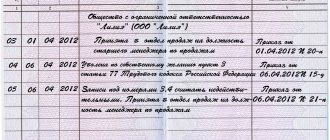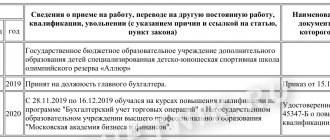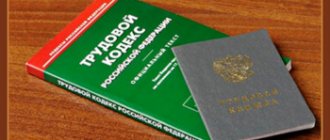Series of work books by year of issue
Currently, 4 types of work books are valid on the territory of the Russian Federation, the forms of which were approved by resolutions:
- Council of People's Commissars of the USSR dated December 20, 1938 No. 1320;
- All-Union Central Council of Trade Unions, Council of Ministers of the USSR dated 09/06/1973 No. 656;
- USSR Council of Ministers dated April 21, 1975 No. 310 (work books of collective farmers);
- Government of the Russian Federation dated April 16, 2003 No. 225.
Old-style work books
Issued from the beginning of 1939 to the end of 1973 in a hard cover made of purple leatherette with the coat of arms of the USSR.
Size 148 x 105 mm. The books were produced in two versions: 40 pages (in Russian) and 80 pages (in Russian and the language of the union republic).
The title page lacked such details as the name and seal of the institution that issued the document and the signature of a personnel employee.
In addition, the citizen’s full date of birth was not indicated: only the year was recorded.
The dates in the sections of the book were entered in reverse order: year, month, day.
No special security elements (series, number, watermarks) were provided for such books, but no cases of forgery were identified.
Currently, old-style labor can be found among older citizens who continue to work after retirement.
AT series work books
Produced from 1974 to 2003 inclusive. A total of 10 series of such books were published.
All workers from these years have the inscription on the last page: “Goznak. 1974." In this case, we do not mean the year of manufacture, but compliance with the model approved by Resolution No. 656.
The year of manufacture is not indicated anywhere in the labor document; it can be determined by the serial number of the series (Roman numerals) in accordance with this table:
| Work book series | Years of manufacture | |||
| Start | Ending | |||
| AT | – | I | 1974 | 1976 |
| II | 1977 | 1979 | ||
| III | 1980 | 1982 | ||
| IV | 1983 | 1985 | ||
| V | 1986 | 1989 | ||
| VI | 1990 | 1992 | ||
| VII | 1993 | 1997 | ||
| VIII | 1998 | 2000 | ||
| IX | 2001 | June 2003 | ||
| X | July 2003 | December 2003 | ||
Work books from 1974 to 1992 were issued in a green hardcover made of calico or vinyl. Then, along with forms of this type, forms began to be produced in a pale blue cardboard cover. Size 148 x 105 mm.
Print the series and seven-digit number in labor. books of the AT-I - AT-VII series were written in red ink, then in the forms of the AT-VIII - AT-X series the series itself (letters and Roman numerals) began to be printed in black, and the number in red.
These identification details were printed on the following pages: 1, 5, 9, 13, 17, 21, 25, 29, 33, 37.
During the existence of the USSR, forms were also produced in two formats: for citizens of the RSFSR - 40 pages, for citizens of the union republics - 80.
All sheets of work in the AT series are protected with single-color “snake” watermarks, clearly visible in the light.
Work book of a collective farmer series ROS
In 1975, the collective farmer's book was introduced. Such a document was issued to rural residents who were members of a collective farm.
The form is called “Collective Farmer’s Work Book”, has a series of ROS, and instead of information about work, it contains the section “Membership in the collective farm”. In other respects, the collective farmer’s labor document is similar in appearance to the AT series form.
Work books series TK
Work books of the 2004 model are strikingly different from their predecessors. Size 125 x 88 mm, gray hard cover made of fabric or paper vinyl with the coat of arms of Russia, made in golden color.
Number of pages – 46. Issued with the TK series, while the series is printed in black, and the seven-digit number is printed in red. These identification details are located on the following pages: 1, 3, 9, 15, 19, 23, 27, 31, 33, 37, 39.
On the last page there is the inscription: “© MPF Goznak. 2003. B".
Have a high level of protection:
- the inscription “Work book” located on each page and glowing green in ultraviolet light;
- watermarks in the form of two-tone TK symbols, arranged in a chaotic order and visible against light;
- printing method with a smooth color transition – iris printing;
- stitching with a special “Bicolor” thread, eliminating the possibility of replacing sheets.
Currently, 6 series of work have been released. new sample books:
| Work book series | Years of manufacture | |||
| Start | Ending | |||
| TK | – | – | 2004 | 2005 |
| I | 2006 | 2007 | ||
| II | 2008 | June 2010 | ||
| III | July 2010 | 2012 | ||
| IV | 2013 | October 2015 | ||
| V | November 2015 | Until now | ||
Inserts in labor. book
Inserts in the work book were introduced by decree of the All-Russian Central Council of Trade Unions, the Council of Ministers of the USSR dated 09/06/1973 No. 656. Thus, they began to be issued in 1974 along with labor. books approved by the above-mentioned legal acts and had the same series - AT. A total of 4 series of such inserts were produced.
Modern labor inserts, the shape of which is approved by Decree of the Government of the Russian Federation dated April 16, 2003 No. 225, are of the VT series.
Correspondence of series of inserts to years of manufacture:
| Series of inserts in the work book | Years of manufacture | |||
| Start | Ending | |||
| AT | – | I | 1974 | 1980 |
| II | 1981 | 1987 | ||
| III | 1988 | 1994 | ||
| IV | 1995 | 2003 | ||
| VT | – | – | 2004 | 2012 |
| I | 2013 | Until now | ||
Electronic work books
Plans to introduce electronic work books in the Government have been brewing for a long time, while every year the project to introduce electronic records of citizens’ labor activities is postponed again.
Today, the Ministry of Labor promises to launch a working version of the electronic service record system in 2020. Already, the Pension Fund database contains 80% of information about labor. activities of individuals.
In order to completely abandon paperwork. books, a large amount of work is required: amending legislation, developing additional reporting to the Pension Fund for employers, introducing new software, ensuring the safety and reliability of information storage, etc.
Whether the Ministry of Labor and the Pension Fund will cope with the task - time will tell. But until 2020, the main document confirming a citizen’s work experience remains a paper work record book.
We have selected for you the best offers for individual entrepreneurs and LLCs on opening a current account.
Opening a current account at Tinkoff Bank
- 6 months free for new individual entrepreneurs and small businesses (LLC).
- Opening in 1 day.
- Integration with online accounting (automatic calculation of the simplified tax system, UTII, insurance premiums).
- 6% on account balance.
Apply for account registration in 9 minutes
Opening a current account at Tochka Bank
- Free opening of a current account.
- 3 months of free service.
- 7% per annum on the balance every month.
Apply for account registrationbest mobile bank 2020, 2016, 2017
Opening a current account at Vostochny Bank
- 3 months free.
- Overdraft immediately after opening.
- Online account registration.
Apply for business loan account registration immediately after opening the account
Opening a current account at Otkritie Bank
- Free opening of a current account.
- Service 0 rub. per month.
- Online registration.
Apply for account registrationspecial offers from AmoCRM, Tilda, Shiptor, Insales
Opening a current account at VTB Bank
- Free opening of a current account.
- Free service for 3 months.
- Online registration.
- Transfers and cash transactions 0 rub.
Apply for account registration cash transfers 0 rub. commission
Features of making various entries
A work book is a document that reflects the state of your work activity. That is why this document should be treated with the utmost care. Depending on what position you work in, as well as what processes occur in the field of work you perform, your work book is filled out.
An HR department employee must know all the nuances of recruiting workers of any profession and, if possible, be able to carry out these actions quickly and without errors.
Entry in the driver's work book
The profession of a driver implies a traveling nature of the work. But this fact is not at all reflected in a document called a work book.
In order to hire a driver, he must have certain documents. It is the HR department employee who must clarify their availability, because if they are completely absent, the citizen will not be hired due to the fact that he simply does not correspond to the proposed position.
Essential documents include documents confirming that the driver is completely healthy and nothing prevents him from carrying out his work function. That is, the citizen must have the result of a medical examination in hand.
Also, a document must be provided indicating that the driver has a license of the required category. Many personnel department employees mistakenly believe that in the line about a citizen’s position, in addition to his profession, he must enter the make of the car. The car that the driver must drive does not play any role and, accordingly, such information will be superfluous.
In order for the driver to be hired, you also need to wait for a special order to be issued.
When information about the job is entered into the employment record, in the third column of the form you need to succinctly write: “Accepted as a driver.”
Sometimes, if the employee works part-time or temporarily, this fact can also be indicated.
Entry in the work book about hiring a driver - sample.
About maternity leave
Going on maternity leave is a joyful event, because soon someone will become a happy mother, which means they have every right to take a break from work for a while.
Unfortunately, many HR employees still think that it is mandatory to make a record of an employee going on vacation. This fact is wrong.
Not a single regulatory act says this . When the main employee goes on maternity leave, her work experience is not interrupted; it continues despite the fact that she is absent from the workplace. But a new employee performing duties during maternity leave must be registered in accordance with the law and all entries in the labor report.
Disabled person
People with disabilities can also have work records. Unfortunately, disabled people of the third group cannot perform labor functions, but the first two groups can easily cope with the work. For example, organizations themselves create certain quotas that are aimed at creating vacancies for disabled people of the first and second groups.
Work books of people with disabilities are no different from ordinary books. The only thing that can distinguish them is the entry about the disability group on the title page of the work report.
This entry is made specifically so that the employer immediately understands that it is impossible to load the employee for physical reasons.
A record of the performance of a labor function is written in exactly the same way as for other employees who are not disabled.
Collective farmer's work book: valid or not
Despite the fact that collective farms were disbanded long ago, many citizens still have the corresponding work books. Many people mistakenly believe that they are not valid and try to get rid of them or exchange them.
In fact, this measure is meaningless. The collective farmer's work book, in accordance with the Government decree, is valid to this day . Unfortunately, many employees do not know about this and lose valuable documents, considering them unnecessary.
A citizen with such a work book has every right to get a job in any position that will correspond to his knowledge and skills without any restrictions.
At the notary
Work books of notaries are stored in the notary chamber of a separate entity. Many people mistakenly believe that notaries do not have such documents. This is wrong.
Who keeps the work books of notaries? As a rule, this is done by employees of the federal notary chamber or the chamber of the subject. In addition to the date and number of the president’s letter by which he was appointed, the notary’s work book contains the name of the notary’s office where he carries out his activities.
For example, the entry may look like this: “Notary office No. 2 of the Voronezh region. Voronezh. Notary".
Foreman position
Many people do not know how exactly the position of a foreman is written in the work book.
If this employee is an official in any organization, then he must be properly registered.
The foreman is appointed to the position by order of the organization . The foreman also has his own official title, which is used in documents. Thus, in the line: “Information about the work,” we write the following phrase: “LLC Stroika, position – work producer.”
This entry is relevant for this profession.
Student cases
As a rule, a student is an employee who performs a labor function part-time. As usual, such workers are classified as temporary or part-time workers. That is why the entry in the work book of such workers must be appropriate.
For example: “Romashka LLC. Hired as a temporary manager." Or another option is possible: “Luchik LLC. Hired to the position of part-time security guard.” Sometimes, when a student is not away from work to study, he is recorded in the work book as a full-time employee. Then the entry in the work book looks like this: “Mammoth LLC. Hired to the position of sales consultant.”
Externally, a student’s work book is no different from a document of a full-fledged specialist. However, on the double page of the student’s work report there is no record of education due to the fact that he is in the process of obtaining a diploma.
Study record
On the main spread of the work book there is a specialized chapter called “Education”. After this word there is a mention of which educational institution the employee graduated from and who he is in fact. For example: “initial vocational, secondary vocational.”
But many employees do not stop at one option for their self-development. Many receive higher education in addition to secondary education, and many go for a second higher education.
Of course, there is no longer a column left on your work record to enter all your achievements in your studies.
But on the white sheet located on the left, the legislator allows you to leave notes about your new status, for example: “The education record has been supplemented due to the fact that you received a higher education as a lawyer.”
At the teacher's
Teachers, like other citizens of our country, keep work books in which their positions in educational institutions are entered. But in addition to information about acceptance to a position and dismissal, information about receiving the corresponding categories is recorded in work books. There are about five of them in total, and the highest level is the highest category.
As soon as a teacher receives one of the listed categories, a note is made about this in the work book immediately after the entry for employment. Typically, this entry may look like this: ““The first qualification category has been assigned to the position of teacher.”
It is imperative to complete the entry with the seal and signature of the director of the educational institution.
At the accountant's
An accountant can be hired for his position, either under a fixed-term contract or in its absence. One way or another, but depending on this, a record of hiring an accountant is formed.
Otherwise, the entry in the work book of this official is practically no different from the entry in other work books . An example of an entry in the work book of an accountant of one of the large organizations: “LLC Gazovod. Hired to the position of chief accountant under a fixed-term contract.”
An entry in the work book must also be supported by an appropriate order, seal and signature of the director or deputy of the organization.
Series of work books by year of issue in 2019
In 2020, on the territory of the Russian Federation, a work book form is used, approved. GD of the Russian Federation dated April 16, 2003 No. 225 (actual edition dated March 25, 2013). This Resolution also defines uniform Rules for their production, registration, and storage. The form of the insert (hereinafter abbreviated as VK) for it is, in fact, an analogue of the work book template (hereinafter abbreviated as TK). It includes the same sections as the standard work book form, but there are fewer pages in it.
Both forms (TK and VK) are produced according to the general standard, sample, approved. Order No. 117 of the Ministry of Finance of the Russian Federation dated December 22, 2003 and have the appropriate degree of protection. Links to approved standard samples of the labor document (LC) and the insert (VC) for it are given below in the table.
| Links to TC samples | Links to VK samples | ||||
| Work book (cover, title) | Sec. "Job information" | Sec. "Information about awards" | Insert in labor | Sec. "Job information" | Sec. "Information about awards" |
The production of forms is carried out by the Goznak Association of the Ministry of Finance of the Russian Federation. According to Order of the Ministry of Finance of the Russian Federation No. 117n dated December 22, 2003, labor and inserts are not issued free of charge. Employers purchase the required number of forms under the contract directly from manufacturers or distributors.
The standard labor form, which is currently used, contains the following details:
- The coat of arms of the Russian Federation is golden in color and the inscription “Labor book” (on the front cover and title).
- The series is printed in black and its number is in red (placed on every 4 pages of the unfolded sheet).
It is self-evident that today the series, like its number, are the constant attributes of a Russian-style work book. They allow you to find out its authenticity and the actual year of manufacture.
Actions of the employer in case of loss of the work book
Even if the necessary conditions for storing personal documents of employees are observed, cases of loss or damage to work records are possible. Let's consider two possible situations:
- The book was lost or damaged by a HR employee (intentionally or accidentally). In such a situation, it is necessary to issue a duplicate, and this responsibility lies solely with the employer. Data on the employee’s length of service can be taken from the personal card; previous jobs are indicated in one generalized entry (clause 32 of the Labor Code Regulations).
- An emergency incident, as a result of which personnel documents were massively destroyed. In this case, the executive branch creates a special commission that establishes work experience on the basis of other documents or testimony of colleagues (clause 34 of the Labor Code Regulations).
In all cases of loss of a document due to the fault of the employer (as well as refusal to issue it or incorrect formulation of the reason for dismissal), the employee will have to pay wages for the entire period of actions to correct/restore it, and the new day of dismissal will be considered the day the work book is issued in hand.
Restore lost employee documents correctly by reading the article “Duplicate work book - sample filling”.
Historical information about the appearance of the “AT” and “ROS” series
It should be noted that work books, which were just beginning to be produced during the Soviet Union, did not have any details or protection at all.
The first standard forms were an ordinary purple “crust” with the coat of arms of the USSR. The document was made of leatherette in two versions: 40 pages (Russian version) and 48 (in Russian and in the language of one of the union republics). Interestingly, on Soviet forms:
- there are no watermarks;
- the title did not have a seal, the name of the organization, or the signature of the personnel officer;
- when filling out, only the employee’s year of birth was indicated, and the date was written in reverse (first - the year, and then the month with the date).
Over time, the form of labor has changed. At first they began to produce vinyl (calico) forms with a green cover, and after a while - cardboard ones in a pale blue color scheme. Starting in 1974, it first appeared with the AT series with the corresponding serial number. In total, 10 similar series were released (starting from 1974 and ending in 2003).
So, the series on work books of that time contained letters and an assigned serial number consisting of Roman numerals. For example, “AT-I”, “AT-II”, AT-III”, etc. to AT-X. The year of manufacture was not indicated anywhere, but it was possible to find out precisely by the serial number that followed the letters.
Thus, the AT-I series indicates the beginning of the year of manufacture (year of manufacture) - 1974 and its end - 1976. Further, the AT-II series has the beginning of the year of manufacture. falls on 1977, and the end - on 1979. For the AT-III series, the beginning of the year. - 1980, and the end - 1982. And so on in order of priority. The mentioned details were listed only on pages 1, 5, 9, 13, 17, 21, 25, 29, 33, 37.
Also, since 1975, a collective farmer’s work book, which has the “ROS” series, was developed and introduced for villagers. It was intended for those working citizens who were on the collective farm. Its form, for the most part, corresponded to the AT labor series. It differed only in the series (“ROS”) and the presence of sections. "Membership in a collective farm." It replaced the section with job information.
Series "TK" by year for the period from 2004 to 2020.
Separately, it should be noted that the series has also undergone changes. The new series, which replaced the “AT” after 2003, was developed according to the same analogy, i.e. letter combination + Roman numerals. Its appearance is directly related to the approval of work books of a new type and dates back to 2004.
The updated work book of 2004 has a hard cover, watermarks, iris printing, and distinctive stitching with a special thread called “Bicolor,” which indicates the highest level of protection. On its last page there is Fr. The presence of the listed identifying details indicates, first of all, that this is a real official document produced by Gosznak.
Labor forms of this time have a series that begins with the letter combination “TK”. So far, 6 such episodes have been released. All of them, together with the appropriate year of manufacture (YO), are systematized and displayed in the table.
| TK series | G.v. (beginning - end) |
| TK | From 2004 until 2005 |
| TK – I | From 2006 to 2007 |
| TK-II | From 2008 to June 2010 |
| TK-III | From July 2010 to 2012 |
| TK-IV | From 2013 to October 2015 |
| TK-V | From November 2020 to the current year |
To summarize, it is necessary to summarize that in 2020, employers use the latest sample forms, approved. Order No. 117n of the Ministry of Finance of the Russian Federation. They were assigned the TK-V series. Watermarks (“two-tone” TC symbols) are visible to the light and are placed randomly.
| ★ Best-selling book “Accounting from scratch” for dummies (understand how to do accounting in 72 hours) > 8,000 books purchased |
What are the series of inserts?
Inserts for the work book first appeared in 1974. They were introduced by Decree of the All-Union Central Council of Trade Unions, Council of Ministers of the USSR No. 656 of 1973. Work books of that time had the “AT” series. 4 series of inserts were released for them. In particular, the following series were used: “AT-I” (1974-1980), “AT-II” (1981-1987), “AT-III” (1988-1994), “AT- IV" (1995-2003).
Since 2004, along with the development and approval of new labor models, inserts of the “VT” series, black in color, began to be used. It is also differentiated depending on the year, namely:
- The "VT" series was used from 2004 to 2012.
- Series "VT-I" - from 2013 to 2020
Consequently, in 2020, labor forms have the “TK-V” series, and the inserts for them have the “VT-I” series. A serial number is also added to the liner series. It is printed in red. That is, the principle of its design is the same as the employment form.
For example, the series with the number “VT-I No. 5487655” of the insert corresponds to the labor sample that is used in the current year 2019. What is characteristic is that this series is also made in black, and the number assigned to it is in red. Standardly, when registering it, a stamp with o. is affixed to the labor document.
Important! An insert without labor is considered invalid. If it is not sewn in, but simply inserted, pinned or attached with a paper clip, then it has no force and is also not recognized.
Duplicate work book and its details
In case of loss of a work permit or for other justified reasons, a citizen has the right to apply in writing to the employer with a request to issue him a duplicate. The employer can satisfy this request only if the applicant is its employee or a dismissed person.
A duplicate is an authentic copy of the work, therefore, it must fully correspond to its original. There is no separate form for it. It is drawn up on a standard standard labor form of the latest sample, which is used in 2020. Therefore, all the details that are set for this sample will automatically be assigned to it. This applies, first of all, to the “TK” series and its no.
So, for example, if a labor sample from 1973 (AT series) is lost, the applicant will be given a duplicate in 2020 that corresponds to the updated labor sample (TK series). A duplicate is drawn up in the general case according to the same rules as the labor document, but taking into account the features established by clause 7 of the Instructions for filling out, approved. By Order of the Ministry of Labor of the Russian Federation No. 69 of October 10, 2003.
That is, on the standard form the entry “Duplicate” must be made, then the title is filled out in the usual manner. Then, first, the total length of service confirmed by documents is indicated, and only then the remaining entries are entered in chronological order, etc.
Answers to frequently asked questions
Question No. 1: What standard forms of labor are considered valid in 2020 on the territory of the Russian Federation? Are their outdated models of the “AT” or “ROS” series used today, and which ones?
In the Russian Federation, four types of labor are recognized as “legal”, which were developed and used in their time. These are the forms that are approved. Resolutions of the Council of People's Commissars of the USSR No. 1320 dated December 20, 1938, further, the All-Union Central Council of Trade Unions of the USSR Council of Ministers No. 656 of September 6, 1973, as well as the USSR Council of Ministers No. 310 of April 21, 1975 and, accordingly, RF PP No. 225 of April 16, 2003.
That is, these are labor ones with the above-mentioned “AT”, “ROS” series and even their very first samples, which did not yet have any identification attributes or signs. In everyday life, they are differentiated and named by year: a form of the 1938 model, 1973, a collective farmer’s labor document of the 1975 model, and also a 2004 form.
It should be understood that the concept of “valid” in a given situation is relative. This does not mean at all that you can, relatively speaking, produce an old-style work book and come with it to get a job. These forms are outdated and are not issued to employees today. Therefore, during initial employment, when a person has not yet worked anywhere and for other reasons, they fill out an employment form, approved. PP No. 225.
But old-style labor is legal and has not lost its legitimacy. All of them are accepted by employers, and the entries made in them are recognized and subject to accounting today. There are not so many outdated samples of work records left, however, they are found, most often among older citizens who, being already retired, continue to work.
Question No. 2: The labor standard of 2004 has expired, there is nowhere to make records of work. In this situation, is it possible to continue to record this information in the awards section, crossing out its title and indicating “Job Details” instead?
No you can not. Other actions such as filing regular sheets of paper on a form, drawing up a new work form, etc. are also not allowed. If the work section is completely filled out, there is only one way out of the situation - you need to start one and fill out an insert. Information about it (No., series) should be indicated on the title.
It is noteworthy that the legislation does not establish restrictions on the number of inserts that can be added to a labor account. When preparing and filling them out, it is important to comply with all the requirements stipulated by the general procedure.
Update: December 19, 2020
According to Art. 66 of the Labor Code of the Russian Federation, a work book of the established form is the main document about the employee’s labor activity.
Decree of the Government of the Russian Federation dated April 16, 2003 N 225 “On work books” approved the form of the work book and its insert, which came into effect on January 1, 2004. Also, the said Resolution approved the Rules for maintaining and storing work books, producing work book forms and providing them to employers.
How is a work permit issued upon dismissal of an employee?
Upon dismissal, the employer is obliged to issue a work book and other documents on the last day of work, as well as make a final settlement with him (Articles 84.1 and 140 of the Labor Code of the Russian Federation). An entry on the basis and reason for termination of the employment contract must be made in strict accordance with the wording of the Labor Code of the Russian Federation or other federal law, indicating the appropriate reference to it. If on the day of termination of the employment relationship the employee is absent or refuses to receive a work book, the employer must notify him in writing of the need to receive the document or give his consent to send it by mail.
When contacting the personnel service, an employee who did not receive a work book on the day of dismissal must write an application, and the employer must issue him a document no later than three days from the date of filing the application. If the book was not returned to the employee after his written request, the employer bears financial responsibility for the fact that due to the lack of a labor document the employee is deprived of the opportunity to work: he must pay the average wage until the work book is issued to him.
Work books not received by an employee upon dismissal or unclaimed by relatives in the event of his death are stored in the organization’s archives for 75 years (Article 664 of the List of standard management documents generated in the activities of organizations, indicating storage periods, approved on August 25, 2010 by the Ministry of Culture of the Russian Federation) .
Today in Russia there are three types of work books: 1938, 1973 and 2003. All three samples of work books are valid and do not require replacement.
Work book forms and technical requirements for them
Samples of work book forms and an insert in it were approved by the Ministry of Finance of the Russian Federation by order No. 117n dated December 22, 2003. The aforementioned order of the Ministry of Finance of the Russian Federation No. 117n in paragraph 2 states that the production of work books and forms in a work book according to a single model is ensured by the Association of State Enterprises and Organizations for the Production of State Signs - the GOZNAK Association of the Ministry of Finance of the Russian Federation.
Providing employers with work book forms is carried out on a paid basis under an agreement with the manufacturer or distributor. In this case, the distributor of these products can be a legal entity and (or) an individual entrepreneur who, in accordance with clause 3 of the Procedure for providing employers with work book forms and an insert in the work book, approved by Order of the Ministry of Finance of Russia dated December 22, 2003 No. 117n “On work books”, can be engaged by the manufacturer to provide employers with the specified forms.
Delivery of work book forms and its insert is carried out under guard, using units of the State Courier Service of the Russian Federation, the Main Center for Special Communications (Special Communications) of the Ministry of Information and Communications of Russia, the Ministry of Internal Affairs of the Russian Federation or departmental security of federal executive authorities.
Based on the approved form of the work book, the coat of arms of the Russian Federation and the inscription “WORK BOOK” are located on the cover of the document. On the first title page, in addition to information about the employee, there is also a corresponding inscription and coat of arms (in the upper left corner), while the series and number of the document are indicated on every fourth page. It should be noted that the series is made in black, and the number is highlighted in red.
How to fill out a collective farmer’s work book
If the work book is filled out simultaneously in the language of a union, autonomous republic, autonomous region, autonomous region and in the official language of the USSR, then both texts are certified (clause as amended, put into effect on July 1, 1991 by Resolution of the Council of Ministers of the USSR dated August 15, 1990 N 829. 10. In the work book of a collective farmer serving correctional labor without imprisonment, an entry is made that the time spent serving correctional labor is not counted in the total and continuous work experience. 11. A person who has lost the work book of a collective farmer must immediately report this to the board collective farm. No later than 15 days after the application, the collective farm board issues another work book of the collective farmer with the inscription “Duplicate.” 12. For forgery or use of a knowingly false work book, the perpetrators are liable in the manner prescribed by law. 13.
Liner
In the professional activities of some citizens, there comes a time when the “Work Information” is completely filled out and there is nowhere to enter new data. Some employers find creative ways out of the situation, for example, entering information into the “Award Information” section, crossing out the title inscription on the page, or filing blank sheets of paper.
None of the above actions are acceptable. If the “Work Information” column in the work book is full, the employee is given an insert. Information about it is entered on the title page, in the upper right corner. Indication of the series and number of the issued insert is mandatory.
It is possible to either enter information by hand or fill out a 10x25 mm stamp imprint. The numbering of entries during the design of the insert continues.
Information about the education and personal data of the employee is filled out on the basis of the documents provided, and not the title page of the employment record, since personal data may well have changed since the moment of first employment, a higher level of education has been obtained.
Like work books, the inserts in them can be compared by series and year of issue.
Series of inserts for work books and year of issue
Old-style work books
Work books have a large number of differences, but they still have similarities. How many pages are there in an old-style work book? Each view contains 40 pages.
1938
Purple leatherette cover, 14.8 x 10.5 cm, 40 pages. The inscription and drawing are applied in black paint. No protective signs were used. The appearance of the first sheet of the work book is simple: there is no series and number, no coat of arms; to record information about birth, only the year of issue is indicated.
The employer's stamp and the signature of the HR employee were not affixed; data on work activity is filled out in the year, month, day format. It has been issued to workers and employees since 1939. Entries were made in two languages: Russian and the language of the republic. Almost no cases of forgery were recorded.
Sample of a work book form from 1938.
1973
Green binding is made of calico or made of blue cover paper, A6 format, 40 pages.
Historically, it was the books of the second type that were subject to counterfeiting much more often. The title page indicates the series and number of the book, the coat of arms of the USSR and the inscription “Labor book” are printed.
There is a place for the signature of the person filling it out, the personal signature of the owner and the official seal of the issuing organization. The date of birth began to be entered in full, with the month filled in in words.
Issued since 1974 to all workers and employees. Watermarks are provided: when held up to light, snake-like lines can be seen on each sheet. Filled out in Russian and the language of the republic. The last page is labeled “Goznak”.
Sample of a work book form from 1973.
1975 (collective farmer)
Green cover, size 14.8 x 10.5 cm, 40 pages - this document was issued only to rural residents who were members of a collective farm. The title page indicating the number and series, the coat of arms of the USSR is printed, there is the inscription “Collective farmer’s work book.”
Information about workdays worked, their minimum number and the established norm was entered into it annually. Accrued income was also indicated here (in amount or in natural products). Filled out in the language of the republic and Russian. There are watermarks - serpentine lines visible in the light.
Issued since 1975, continuation of this document is not recommended; a general work book is issued, which is maintained in parallel. The last page contains the inscription “Goznak”.
Sample form of a collective farmer's work book.
2003
Gray binding with silver lettering and double-headed eagle.
Issued to all employees of Russian companies, regardless of citizenship, and to employees of foreign companies with a permanent representative office in the Russian Federation. Size 88x125, which is smaller than all previous forms. Has 44 pages, issued and valid since January 2004. Increased degree of protection:
- The inscription “Work book”, which glows in ultraviolet light;
- Seam preventing the possibility of replacing sheets;
- The letters “TK”, visible in the light;
- Iris print.
What does the new work book form look like?
With each change in the forms established by law, there is a period when documents of both types are issued. HR specialists should not forget this.
If a book dated 2007 is issued on a 1973-style letterhead, this is a reason to suspect a fake. If an invalid book is discovered, a report is filled out and the employee is issued a new document that complies with all current standards.
What to do with a collective farmer’s work book
Membership in the collective farm Series and number* (2 spreads) N of entry Date Information on admission to collective farm membership, on termination of membership in the collective farm, indicating the reasons On what basis the entry was made (document, its date and number) day month year 1 2 3 4 * The series and number are indicated on one of the four pages of each unfolded sheet of the collective farmer’s work book. Information about the work Series and number* (6 spreads) N of entry Date Information about appointment to work, transfers to another job, termination of work, indicating the reasons On what basis the entry was made (document, its date and number) day month year 1 2 3 4 * The series and number are indicated on one of the four pages of each unfolded sheet of the collective farmer’s work book.
Work record forms
A work book of a new sample or an old format must be checked by the employer when hiring an employee. Registration of a citizen using forged documents, even if the employer had no idea about the forgery, entails administrative liability if the fraud is detected by the inspection authorities. And these are not the only troubles that arise from the fact of providing false personal data. The assigned periods of work directly affect the amount of compensation for days of incapacity for work, and here we are talking about criminal liability.
Work books are issued exclusively by employers; it is impossible to buy them yourself. The forms are produced at the state enterprise Goznak and issued to employers in strict accordance with the approved lists. The newly organized company must enter into an agreement with a representative of Goznak, on the basis of which the required number of blank forms is purchased. Any legal entity that has submitted an application for distribution and received permission can become representatives of a state enterprise. Representatives are entered into a special register, which is published on the official Goznak service.
Currently, the forms of this document are issued in strict accordance with Order of the Ministry of Finance of the Russian Federation dated December 22, 2003 No. 117n. The order established that the work book should include the following attributes:
- The cover of the form is “decorated” with the coat of arms of the Russian Federation and the inscription “Labor book”.
- On the first page of the form, in addition to the lines for entering personal data, there is also a duplicate inscription from the cover and a reduced image of the coat of arms.
- Each 4th page of the form is marked with an individual number and series.
- The number is written in red ink, and the series in black.
- On the last page below there is information about the manufacturer "MPF Goznak".
- There is also a year there, which speaks not about the moment of issue of the document itself, but about the period of the sample form.
But you can find out information about the date of issue directly from the series and years of work books.
How is a collective farmer’s work book taken into account?
Responsibility for organizing work on maintaining, recording, storing and issuing work books rests with the chairman of the collective farm. Responsibility for the timely and correct filling out of work books, for their recording, storage and issuance lies with a person specially authorized by the collective farm board. For violation of the established procedure for maintaining, recording, storing and issuing work books, officials bear responsibility in accordance with the charter and internal rules of the collective farm, and in cases provided for by law - other responsibility. 14. Collective farm boards take measures to strictly adhere to the established procedure for maintaining work books, strengthen the cadre of workers who maintain work books with people trained for this work, and ensure proper storage of archival documents related to the labor activities of collective farmers. 15.
Series of work books
Work books were introduced as mandatory documents for every worker in 1939. The initially developed form existed without changes until 1974. These papers had no numbers or series, and there were no watermarks. The original cover color was dark purple.
Since 1974, more and more new protection elements have been introduced. The first protective nuances were the assigned series and number to the work book. This numbering remained unchanged until the end of 2003, and since 2004 it was changed.
This approach divides work book numbers by year:
- From 1974 to 2003.
- From 2004 to now.
To check the work book, you just need to have at hand a table of correspondences by year of manufacture and the corresponding individual numbers.
From 1974 to 2003
We will check the work book by series and number.
If we are talking about forms manufactured from 1974 to 2003 inclusive, then it should be taken into account that:
- During this time, ten series from AT-I to AT-X were released.
- All documents of these years had a mark on the last page “Goznak. 1974." This means that the sample is from 1974.
- Both the series and number are written in red ink. The only exceptions are the last three series - AT-VIII - AT-X, which are produced in black format.
- Until 1992, the cover color was only dark green, but since 1993, light blue covers began to be used along with them.
The pages were protected with watermarks that were easily visible against the light. The watermark design was made in the form of wavy lines.
Series of work books by year of issue:
- AT-I were assigned from 1974 to 1976.
- AT-II was manufactured from 01/01/1977 to 12/31/1979.
- AT-III – 1980-1982
- AT-IV from 1983 to 1985 inclusive.
- AT-V was used for 4 years from 01/01/1986 to 12/31/1989.
- AT-VI were manufactured for 3 years - 1990-1992.
- AT-VII from 1993 to the end of 1997.
- AT-VIII was printed for 3 years - 1998 - 2000.
- AT-IX from 01/01/2001 to 06/30/2003.
- AT-X from 07/01/2003 to 12/31/2003.
The publication of work books of this format and series has no longer been carried out since 2004.
From 2004 to present
A new format of forms was introduced at the beginning of 2004. The document became slightly smaller in size, and the cover color was changed to dark gray. The series of work books have also changed from AT to TK. Several series have been released - TK, TK I, TK II, TK III, TK IV, TK V.
Several levels of protection were added to the new work book:
- On each page, under ultraviolet light, you can see the inscription with the name of the document, which glows green.
- When exposed to light, you can see the letters TK, located randomly throughout the entire page.
- The sheets are stitched with a special two-color “Bicolor” thread.
- On the last page of all copies there is marked “MPF Goznak. 2003."
Let's consider the correspondence between the series of work books and their numbers:
- In 2004 and 2005, books in the TK series were published.
- Samples of 2006 and 2007 come under the TK-I series.
- The TK-II series corresponds to 2008 – 2010.
- TK-III were manufactured in 2011-2012.
- From January 1, 2013 to September 30, 2015, the TK-IV series was used.
- From the beginning of October 2020 to the present day, forms of the TK-V series have been issued.
Modern documents are always 44 pages. Old sample forms issued earlier are still valid today and, although they are no longer issued to employees who have just begun their working career, they are accepted as a certificate of length of service.
Protection of work records from counterfeiting
Currently, modern printing technologies are used in work books, which can provide a high level of protection against counterfeiting. The forms are made on special paper with a common two-tone watermark “TK” (it can be seen against the light), as well as interspersed with security fibers. A special method is used for printing with smooth color transitions (iris printing). The book itself is sewn with a special seam, eliminating the possibility of replacing sheets.
In different years of issue, work record forms had different degrees of protection. The most vulnerable are the first samples of work records. They had neither a series nor a number by which one could determine the year of issue, as well as other degrees of document protection.


